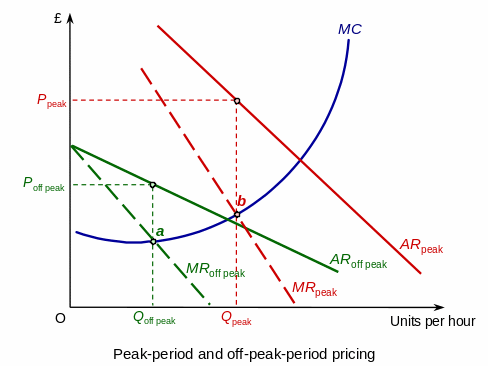Peak Pricing
Peak pricing is often applied by governments and other private entities to balance the forces of demand and supply of a product during high season when the demand is skyrocketing and low season when the demand is very low. This strategy is informed by the need to balance the demand and supply curves to avoid creating shortages when the demand is very high and surplus when the demand is low for a product. This pricing strategy is often applied to a price discrimination tool for maintaining sustainable optimal supply and demand capacity for a product that is consumed depending on the season or period of the year (Shiller 45).
When applying the peak pricing, at the time when the demand is high, the prices are increased to represent the high peak. The prices are lowered when the demand is low to represent the low peak characterized by few customers demanding a particular commodity at that time. As opined by Wainwright (2012), “by subtracting the marginal costs of operation from the original demands, we find the marginal benefits of capacity, which must then be vertically aggregated and equated to the marginal cost of increasing capacity” (Wainwright 33).
In most cases, the high peak pricing may encourage a potential customer to be flexible and reduce demand when the prices are high in order to postpone the purchase of the product when the prices come down during off-peak characterized by the availability of excess capacity to consume. In order to create an optimal capacity for balancing the demand and supply side of a commodity, the peak prices in low season and high season are harmonized by summing the marginal costs (MC) of different operations and generated marginal benefit for each period, that is, low and high peak (Shiller 24).
The primary intention of charging high prices during high season is to balance of elasticity of demand, which is often very low during the high demand period unlike during off-peak season when it is very high. This is illustrated in the chart below.

Example
Peak pricing is often applied in the managing demand and supply of electricity during high peak and low peak seasons. During the low peak, power stations that are operated with the lowest costs are preferred, such as coal-fired and nuclear. However, during high peak, the generation of electricity will have to be supplemented by high-cost power stations such as gas and oil-powered plants. This means that the marginal cost of producing electricity during high peak is higher than the marginal cost of doing the same during low peak. Therefore, the prices during a high peak must be higher than prices during a low peak in electricity production and consumption (Grinblatt 31).
Basically, the rationale for charging high prices for electricity during peak is informed by very high demand from consumers who use more power during this period. On the other hand, the low prices charged on electricity consumption during low peak are a result of the low marginal cost of producing electricity and demand during this period. Therefore, the application of peak pricing under this example is a means to balance the demand and supply constraints of providing electricity during high peak and low peak to create an optimal demand and supply function. In the end, customers who are able to postpone their consumption during high peak can reap the maximum benefit of consuming electricity when the off-peak prices are low as a result of low demand.
Works Cited
Grinblatt, Michael. The Disposition Effect and Momentum, New York, NY: Wiley and Sons, 2003. Print.
Shiller, Ronald. Irrational Exuberance, New York, NY: Princeton University Press, 2005. Print.
Wainwright, Simon. Principles of Accounting, San Diego, CA: Bridgepoint Education, Inc, 2012. Print.